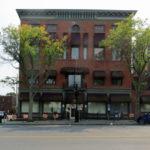POUGHKEEPSIE – An estimated group of 200 protesters lined Market Street in Poughkeepsie Thursday afternoon to denounce the county’s plan to move forward with the construction of a new county jail, known as the Dutchess County Justice and Transition Center.
Following the protest, county lawmakers meeting in the Budget, Finance and Personnel Committee voted eight to four to move forward with the project.
The $200 million investment is considered the largest capital project in Dutchess County history, Legislature Minority Leader Rebecca Edwards said during the protest.
Edwards and her Democratic colleagues were joined by organizations including the Dutchess County Democratic Committee, Stop the Violence, and Nobody Leaves Mid-Hudson to bring attention to the costs associated with a new facility. Edwards and her fellow lawmakers are seeking to stop the issuance of the unused portion of the bond for the project, totaling more than $132 million.
(video: Action News Service for Mid-Hudson News)
The debate over the need for a new county jail has been addressed by the county legislature as far back as the mid-1990s. An overview of the debate can be found here. Edwards says that the Democrats on the legislature are asking for the county to “Re-think what it means to spend this much on a jail,” given the current climate, combined with a reduced number of inmates due to bail reform laws. It was not uncommon for the county to send their inmates to other counties, at a cost of millions annually, because there was no room at the overcrowded jail in Dutchess.
According to Superintendent Michael Walters, the jail administrator, the maximum number of inmates allowed at the facility is approximately 292. “When bail reform went into effect in January, our population dropped,” said Walters. “The COVID pandemic impacted the system because the courts were shut down and people were not being sent to jail.” On July 1, reforms to the bail reform laws went into effect which give judges more freedom to remand those accused of crimes to county jail. In June, the jail was averaging 138 inmates per day. The jail administrator said that number is likely to increase with courts reopening and judges granted more discretion once again. The Dutchess County Criminal Justice Council’s recommendations for the project can be found here.
Democratic lawmaker Giancarlo Llaverias was asked to weigh the difference between maintaining the inadequate current jail versus a new one and said, “I don’t mind fixing what is broken because even those in jail have human rights to a proper building.” Addressing the call for additional capacity at the facility, Llaverias said, “The bigger picture is that the jail in no way improves the community. It has been proven that jails are systems that disproportionately arrest people of color and poor whites.”
County Executive Marcus Molinaro has been proposing a new center since taking office several years ago. “We committed to a complete overhaul of our justice system – from prevention to intervention and diversion services. The county jail built in 1984 to warehouse those in our care needs to come down. It’s unsafe, ineffective, and inhumane. We owe it to those in our care to provide the most effective tools, supports, services, and facility to help them – our new transition does this while saving county taxpayers $4 million a year.”
Asked about the attempt by the Democratic caucus of the legislature to hold back the funds, Molinaro said “Democrats and Republicans voted to move ahead with the project four years ago, New York State mandated it and those in our care deserve better.”
“It is entirely inappropriate for the county to keep inmates in cages at the current facility which is designed as a place of punishment,” said Legislature Chairman Gregg Pulver. “Our goal should not simply be incarceration but rather restorative justice. The county has developed a holistic approach to law enforcement and justice including the stabilization center, community-based policing, youth programs, and incarceration alternatives. The Justice and Transition Center is an integral piece of that plan to provide beds to rehabilitate the population and will only make our community stronger in the long-term.”
Addressing the afternoon protest before the committee meeting, Pulver was critical of his colleagues. “I am surprised that providing persons with dignity and the ability to better themselves was met with such fierce opposition and without any alternatives.”








